~~* The Oregon News Review: A STEP BACK IN TIME *~~
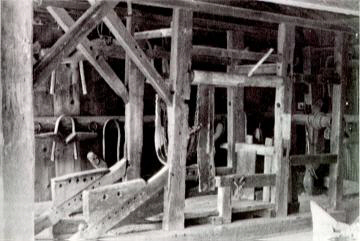
Alexandra Petrowski
Drew, Oregon
The mountain air is crisp and clean after the torrential rains that pummeled the homestead during the night. It's going to be a sunny day, for the mists shrouding the mountain buttes are like gauze and sunlight is beginning to stream through.![]()
I stare out the kitchen window while I strain the morning milk from the red cow. I like to watch my husband yoke his oxen. Bright and Tears stand at attention. Stan has them trained so that they don't move to the right or to the left without his command to do so.![]()
He lifts the heavy wood yoke over Bright's mammoth head. (These steers are now four years old, Holsteins we got as day olds at the auction.) He locks the bow into place, secured around the neck of the ox. "Come under!" he shouts to Tears, the other ox who is standing in place next to the big white ox. Tears has markings more Holstein like -- a lot of black dappled on his muscular frame. The ox slowly maneuvers himself under the yoke as Stan holds his end high. Stan locks that bow in place.![]()
His "boys" (as he calls them) just stand there, soldiers waiting for the next command from their drill sergeant. Stan walks over to the heavy chain and hooks the long chain to the large ring between the yoked oxen. At the end of the chain he puts their "stone boat" - a heavy sled that will help to keep the tips of the logs out of the mud.![]()
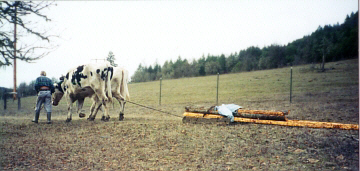
Animals just like these carved Oregon's trails, when pioneers first paved the way from eastern cities to possess a land of milk and honey, the yet unvanquished territory of Oregon. It was the oxen who endured the long journey, their careful plodding steps slower than horses, but their bodies more able to withstand the rigors of the long journey because they adapted so well to being able to endure on harsh pasture grasses. The horses always needed a higher feed and even though they could have made the journey at a quicker pace, tired out early because they could not find suitable pasture to keep them going.![]()
It was not long before the early pioneers realized that oxen were the animals for the long journey, and as those who follow history know, it was the oxen that pulled the wagons. Ever westward, lines of wagon after wagon vaulted onward -- their slow, tedious march marked by the pace of the oxen that pulled the wagons. In the background was always the staccato sounds of the whips and ox drivers who shouted "go haw" or "now gee", walking alongside their sinewy animals.![]()
Stan is soon on the left of the "nigh" ox, Tears (named for the black tear-like markings that seem to drip from each eye), and I can see the bodies of the animals tense, ready for the next command. "Let's go - giddap, boys!" They are all soon out of eyesight, trekking the long country road that winds upward into the forest of our back forty.![]()
There they gather the logs that have fallen during the bad winter storm that last whipped through our mountains. The snows were particularly heavy, and some of our trees toppled with the winds and snows. The man and the oxen make their careful journey to a tangle of firs that have fallen. Stan takes out the chainsaw and the sounds from the back of our property tell me he's going to bring another load of logs back.![]()
He instructs the boys, "Wait here." They do his bidding almost by rote. For some reason this particular morning the barn sitting solitary and inviting way back at the ranch becomes a tangible "pull" to the usually otherwise obedient steers. Stan cuts the wood for a few minutes and then looks around after limbing the first tree . The oxen are gone.![]()
They have turned around and walked back to the dairy shed. I look out the window again, puzzled to see the yoked oxen fidgeting at the gate without my husband at their side. In a moment I walk out to see what is going on and there 's Stan walking down the road with a look on his face that no doubt is the reason for the oxen's fidgeting.![]()
There is nothing he can do except take them again to the spot that they had earlier forsaken and this time tether them loosely to a tree with a few loud reprimands on their way back up to the site. I hear him in the distance "go haw, Bright!! -- haw, Tears!!" and I know that everything is under control again. The ox driver has his whip in hand, but rarely has to use it. The oxen have every intent to do their master's bidding. They've learned that from calfhood.![]()
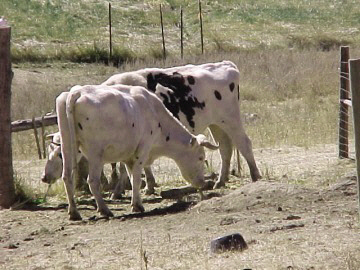
Weighing in at approximately one ton each, Bright and Tears go where "tractors fear to tread." Oftentimes those are muddy paths during winter's hard rains or slicked and slimy spring roads. I'll never forget the ultimate irony that took place when my brother in law's long, heavy and unwieldy Lincoln Continental became entrapped in mud on a road that he inadvertently thought he could climb one spring day. Stan hooked up the oxen's chain to the large car's front axle. "OK, boys, giddap!!" That's all it took. The car was freed from the hold of Oregon's mud. No amount of prodding from the gas pedal earlier by my husband's brother could budge the vehicle. Yet these beasts of burden easily moved their load.![]()
There are signs all along Interstate 5. The signs have pictured on them an ox yoke. As you drive toward Canyonville from Roseburg, the signs read: "APPLEGATE TRAIL MUSEUM". The museum itself is located right off the Sunny Valley exit in quaint Sunny Valley. It was almost two autumns ago that Stan received a phone call from the Josephine County Historical Society. They needed a pair of real live oxen for a film they were putting together about the Applegate Trail.![]()
The movie footage rolled, and Bright and Tears were secured to a covered wagon, antiques lashed to its sides. The film depicted the tragic events that unfolded as the Crowley family made its epic journey into Oregon Territory, over the historic Applegate Trail. The Portland film company captured the essence of pioneer ruggedness, courage and tragedy on film.![]()
At one point in the filming, the director wanted some real "action" and drama to unfold. He asked Stan to take the oxen hooked to their wagon through a small opening between two trees. Stan knew the wagon would have to make a hard turn and that the wood wagon would not be able to make a hard angled turn like our modern day vehicles. The director told him he wanted that footage. Standing next to the nigh ox, Stan drove his team between the trees. As the wagon scraped the side of a tree, it bumped an old butter churn around as well as a wooden water barrel. Barely audible was someone in the background whimpering, "oh, poor aunt Melba's antiques!!"![]()
If you ever visit the Applegate Trail Museum, you'll be invited into the motion picture room to view the short multimedia presentation filmed on three different screens, simultaneously. You'll hear the lowing of oxen throughout the film. You'll see wagons rolling along, and two large Holstein steers guiding those wagons expertly across rocked streambeds, between towering pines.![]()
Those oxen are Bright and Tears, who are the stars on this homestead as well. After the film was shot and the movie stars came home after two long days of shooting reams of film, I began to call Tears "Tears Travolta."![]()
If you ask Stan what he thinks about his oxen, his three words said in a tone of appreciation tell it all. "They're good boys." And I can say, from the vantage point of my kitchen window, yes, they are good boys.![]()
NOTE FROM AUTHOR: The above was penned and sent to the Roseburg News Review for one of their annual Oregon history issues, and I forget the year of its writing. I won a second place for it.![]()

In the meantime, the years came and went uneventfully with the "boys" and they grew to their full stature and hauled many huge logs out of the woods faithfully and carefully as drover Stan helped them along at the nigh ox’s shoulder. Seven good years with the oxen, the lumbering oxen, and Stan worked alongside them well - all three a good team. Then, in September 2001 a tragic accident befell that spotted nigh ox (Tears) and we spent some fretful days and nights nursing the big ox.![]()
In the beginning we thought his injury was minor that in a day or two he'd be on his feet again. He tried valiantly, but was not able to rise. So, day and night we drove down the road to our neighbor Peso's corral (where the accident occurred) to attend to his wounds. I don't know how many hundreds of miles my husband drove to town and back - picking up necessary veterinary supplies so that we could nurse the ox all during that first week.![]()
All the animal disease advice I had given others over the years for their sick and dying critters seemed to suddenly leave me during those first days that the large Holstein lay on the ground in Peso’s corral, unable to stand to his feet. I would have told someone else to "first thing – take his temperature," assuming they’d have a glass basal to do the job. I knew that when these calves were both youngsters and I was doing a thorough job of taking their temperatures with a basal one starry Oregon night, one or the other of them kicked it out of my hand mightily – sending the glass thermometer against the barn wall. It shattered, of course, its mercury ebbing slowly from a fractured tip.![]()
I bought another the next day because the calves were still so sick. It was Tears this time that kicked my hand as I reached delicately to insert that glass tube into a scoury aperture under his tail. Why, that tail whipped around my hand like a lariat, like to have grabbed that thermometer right out of my pinched fingers - and then before I could even think straight that back leg kicked, sending that glass thermometer flying even further than its predecessor. Losing another thermometer, two in a row, I decided firmly that either of those black and white calves could surely die of some dreadful scourge before I’d purchase another basal. And so I never did.![]()
Feeding those sick steers their potions four times a day and two times a night – those bottles of garlic steeped with yarrow flowers, slippery elm and a host of other herbs until the both of them decided that death would be preferable any day – they did manage to survive and come out of their dysentery in spite of these ministrations of mine. And soon they began to thrive on the Oregon grasses and legumes, growing big and strong eventually.![]()
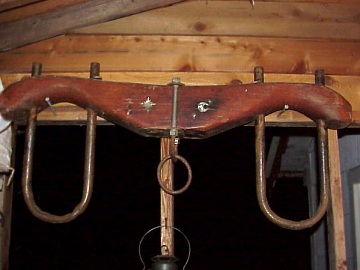
Stan yoked them together early in life – their first yoke a "baby yoke" of sorts – and they soon learned the ropes of what it meant to be what is known as "handy steers." At the age of four years they became full-fledged "oxen" - a name bestowed only on handy steers once they've reached that age. And by then they were pulling some hefty loads. Stan decided early on that Tears had the right temperament to be the "nigh ox" - the one the drover stands by when the load is pulled.![]()
Well, anyway, back at the ranch -- while Stan took his daily jaunt to some dire bleach-tiled veterinary office in one of the cities trying to find out what we could do for this 2,000 pound steer lying in the dust of a forsaken corral, I would be there in that corral doing my best to nurse the ox. I brought him hay bales and kept the water cold in his dish and gave him his pain pills carefully mashed in with his grain. Mostly I just ran my hand over that pink, soft muzzle and spoke to him quietly. I prayed, too - that he would recover - and I never allowed myself the thought that he would not.![]()
Stan didn’t get far with those vets in town. They, being accustomed to dealing with poodles and the like, maybe something as big as a German shepherd, would mostly shrug their white coated shoulders sadly – for they loved all creatures – big and small. But they had to tell him with a mournful look. "I can’t tell you what to do there. I’m not really accustomed to treating oxen." Then someone would call the vet aside and there would be a cat with a runny nose and the vet would excuse himself politely.![]()
The veterinarians did say that the ox needed more than anything to keep his digestive tract moving – and that we’d have to upright him to his feet soon. No one knew quite how to accomplish that feat – that would be our own problem. Of course both of us kept thinking a miracle would occur and that the next morning as we drove up to the corral we’d all of a sudden find him standing on all fours, maybe a bit wobbly – but standing…but he would just lay there anymore – and did not even try to get up.![]()
The day came when we decided to move the ox home. I will never forget that epic journey when with the help of Todd, the heavy and cumbersome immobile ox was moved from Peso's corral onto a flatbed trailer by the use of that boom truck's crane and some slings. Stan rode with the ox on that flatbed as we trailed the highway homeward bound.![]()
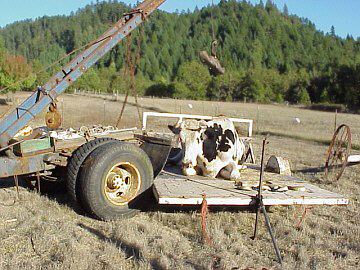
"You should have seen his eyes light up when we entered the home gate," Stan said to all of us, rubbing the steer's neck, laughing aloud. He was right. It was readily apparent that Tears' whole demeanor had changed now that he was home. We took him off the trailer and settled him nicely in his own private "corner" on open ground. At one point he looked up at the blue sky above him and stared long and hard. I wondered about that, about what he was "thinking" at the time. Probably glad to be home, I thought, and forgot about that long look. Only now as I write do I recall that gaze into the wild blue yonder, and I still wonder about it.![]()
We threw him a couple large flakes of green hay that afternoon, which he readily devoured, bid Todd and his wife, Patti, good bye, and settled in for the night. It was good to have the ox home - right there where we could see him from the kitchen window.![]()
The next day as the sun shone brightly we tried to shade him. He kept tearing down the green tarp tents we erected haphazardly on upright T-posts all around him, shade coverings that blew like torn flags in ferocious battle as Oregon's winds kicked up. That same ornery disposition I thought to myself as he flung his big head upward, snatched at a piece of tarp with strong jaws and tore it loose from its mooring. That orneriness in itself gave me indelible hope for his recovery.![]()
It was not to be for long, though, this hope. A week after we'd brought the big steer home things took a bad turn. It was the morning that Todd came over to help Stan with up righting the big steer. The two friends were going to use Todd's old boom truck to lift Tears to his feet. He needed to get up off that hard Oregon ground the vets all said. The men had spent careful time deliberating - and all things were put in order beforehand.![]()
Though we never could have predicted this would be Tears' last day on earth when we began moving him that morning, it was apparent soon enough that the old boy was dying. It did not have anything to do with our moving him. Two days before he had gone off feed. Perhaps we were all just holding onto hope because that's all we had at that point. We never did get him to his feet that morning, for all of a sudden - unexpectedly - even before being really lifted at all - he began to die on us.![]()
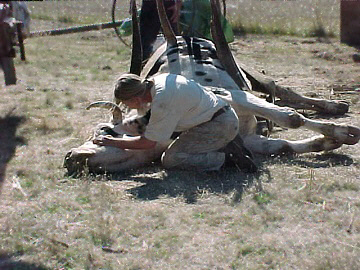
For a few moments, that stubborn Oregon drover I married wouldn't accept the steer's nonchalance about staying alive.. Kneeling beside the big head of his ox, Stan began to shout commands as though the animal would suddenly rise by dint of sheer will power alone, blind instinct driving him to obey the teamster. That was the hardest, I think, those moments when it was apparent the ox was on his way out and the drover, my spouse, couldn't bear the losing.![]()
Todd, neighbor Julie (who had just arrived) and I, well, we remained silent in the dusty background. The parting was altogether too private - belonging only to the drover and his ox, for sure, and we had nothing to do with that sacred moment in time when the drover bid his ox goodbye. It was another Oregon scorcher and all of us were smothering in both heat and sorrow, and the tears gathered in my eyes.![]()
My strong husband continued to call out to the ox, but Tears was not listening any longer. I saw that the light in his eyes faltered. Then those brown orbs glazed over and I saw no more rising or falling in that chest. Stan, obsessed, stricken, grieving, called out only once more, and perhaps the steer still had ears to hear - but he couldn't do anything about it. "Tears!!! Tears!! No, Tears, don't go! Don't go!!!" I felt a pressing weight on my heart. Because he hurt, I hurt.![]()
Julie had caught the last few moments of Tears' life on camera. Thank you, friend, for biting your lip hard and through your own tears taking those shots even though everything in you fought against clicking the frames. As you told us later, you feared to intrude into such a private and painful moment. The photos are truly priceless. I posted the last one you took above. I can still hear my husband sobbing when I see it...![]()
*****
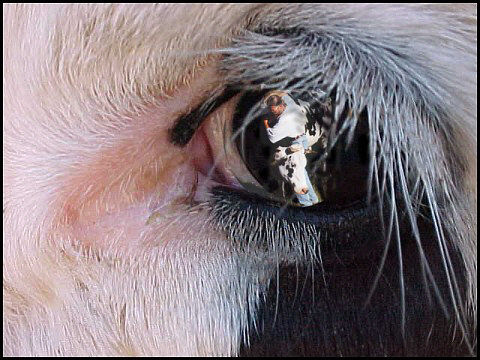
Bright, the off ox, remains alone these days. It’s been hard for him, too. Don’t ever believe that animals don’t feel emotional pain. He was beside himself with grief for a very long time. Now he is finally learning, after all this time, to graze alone in these wide pastures. He likes having the sheep nearby, but sometimes they wander off and he’s there all alone. He's learning how to cope after being yoked for seven years beside his brother.![]()
I told a few kind folks of our loss right after Tears passed away. Many friends responded with incredible sympathy, as though they fully understood my husband's pain. It was especially the drovers, though, who surprised me. One man wrote, "Yep, it's like losing one of the family." Then there was Tim. Tim, another drover from back east, knew that Stan wanted to make a "single yoke" for the remaining Bright ox, and knew that my husband was stymied a bit as to how to put the yoke together.![]()
Tim's e mail said that he'd known single oxen to pull great loads. And just to show you that kindness knows no bounds among fellow drovers, Tim mailed my husband hand drawn plans for a single yoke. The "lone ox" concept? Stan is willing to give it a sturdy try. Maybe Bright will be able to handle the load just fine.![]()
Oh, and that last shot above is a gem, don't you agree? Stan (the artist when it comes to this computer) put the "composite" together during those difficult days after Tears' death. I had not seen it until this morning when I retrieved this story and asked him to search for Julie's photos. I knew immediately when I saw this one called "Tears' Eye" that it had to be included herein.![]()
That's not a flash of light in Tears' brown eye framed by long bovine lashes. That's a photo of Tears hugging Stan close to himself with that giant neck of his, the way he liked to do. The photo is cleverly superimposed on a close up of the ox's eye.![]()
Indeed, the picture is fitting. If anyone fit the description of being "the apple of Tears' eye" - it was Stan. The mammoth black and white steer loved no one on earth more than he loved my husband. And I know if he could have lived longer for him, he would have. Just like he would put his massive and muscled shoulders to the task and give it all he had in the days when he would pull the load, he would have done anything in his power to please the drover. But on that harrowing September day, it was just too much for him, though I do know if he could have - he would have.![]()
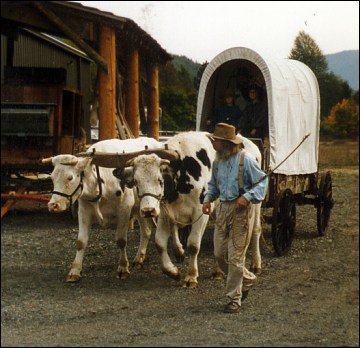
 †
†
Alexandra Scribe
Homestead Home
TOP






